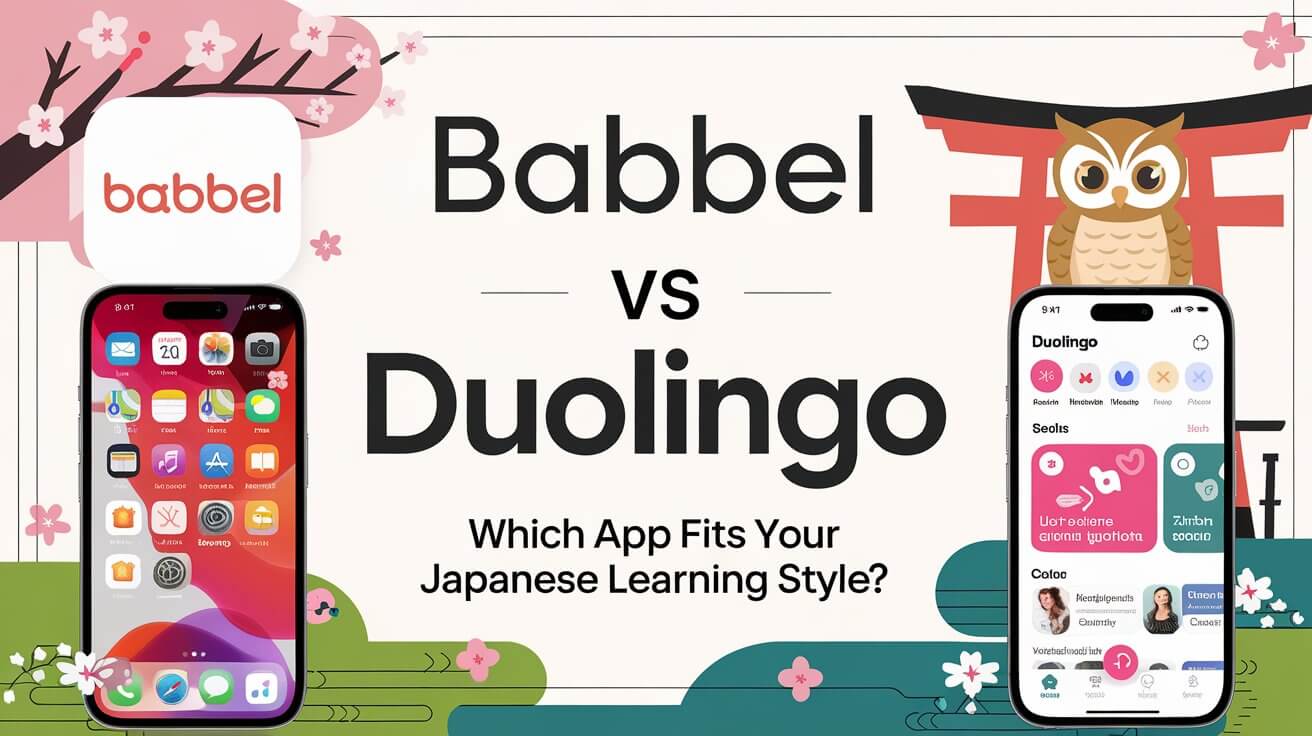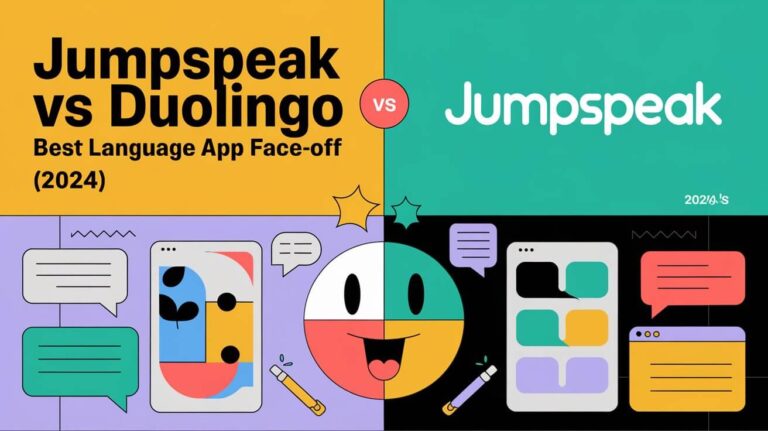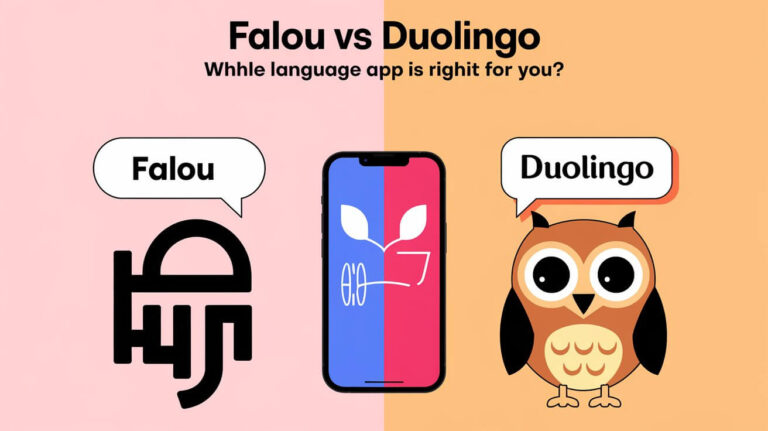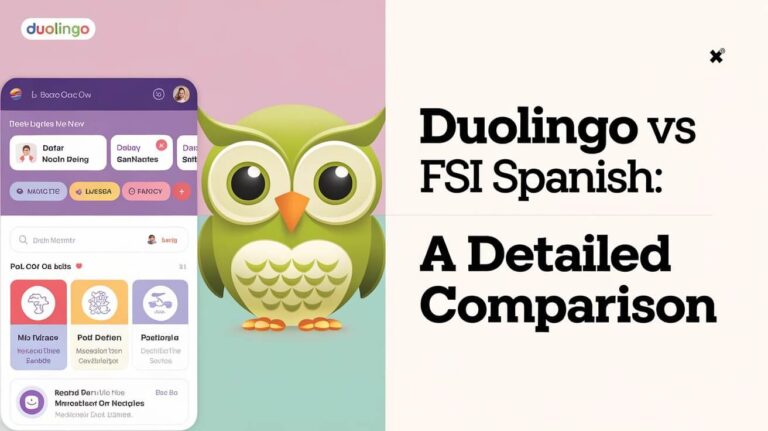Ready to learn Japanese? Picking the right app can help a lot. Many people use Babbel or Duolingo, but they’re pretty different.
This article compares these apps to help you choose. We’ll look at how they teach, what they cover, and how much they cost. You’ll see which one fits your needs better for learning Japanese.
Japanese Language Learning Apps
The digital age has revolutionized language learning. Apps like Babbel and Duolingo have made it easier than ever to learn Japanese on the go. But how do they stack up against each other?
Overview of Babbel for Japanese
Babbel takes a structured approach to teaching Japanese. It’s designed to get you speaking from day one.
Babbel’s Japanese Course Structure
Babbel breaks down its Japanese course into bite-sized lessons. Each lesson builds on the previous one, creating a solid foundation for language growth.
The app focuses on practical, everyday Japanese. You’ll learn phrases you can use right away in real-life situations.
Key Features of Babbel’s Japanese Program
- Conversation-based learning
- Speech recognition technology
- Review sessions to reinforce learning
- Cultural tips integrated into lessons
Babbel’s speech recognition feature lets you practice pronunciation. It gives instant feedback, helping you sound more like a native speaker.
Babbel’s Approach to Teaching Japanese Grammar
Grammar can be tricky in Japanese. Babbel introduces grammar concepts gradually, tying them to real-world usage.
The app explains the ‘why’ behind grammar rules. This helps learners understand the language’s structure, not just memorize rules.
Duolingo’s Japanese Learning Experience
Duolingo takes a gamified approach to language learning. It turns studying Japanese into a fun, addictive experience.
Duolingo’s Japanese Course Layout
Duolingo’s Japanese course is set up like a game. You progress through levels, earning points and unlocking new content as you go.
The app uses a skill tree format. Each branch focuses on different themes or grammar points in Japanese.
Unique Aspects of Duolingo’s Japanese Lessons
- Short, game-like exercises
- Immediate feedback on answers
- Varied question types to keep learning engaging
- Leaderboards to compete with friends
Duolingo mixes reading, writing, listening, and speaking exercises. This variety helps reinforce learning from multiple angles.
Gamification in Duolingo’s Japanese Course
Duolingo’s strength lies in its gamification. The app uses streaks, points, and levels to keep users motivated.
Completing lessons earns you XP (experience points). These points help you climb leaderboards and maintain your daily streak.
Comparing Japanese Vocabulary Acquisition
Both apps have their own methods for teaching Japanese vocabulary. Let’s see how they differ.
Babbel’s Vocabulary Teaching Methods
Babbel introduces vocabulary in context. You’ll learn new words as part of phrases and sentences, not in isolation.
The app uses spaced repetition. This means you’ll review words at increasing intervals, helping them stick in your long-term memory.
Duolingo’s Approach to Japanese Vocabulary
Duolingo often starts with individual words before moving to sentences. It uses pictures and audio to help associate words with their meanings.
The app repeats vocabulary frequently across different exercises. This repetition helps reinforce new words and phrases.
Japanese Writing Systems: How Each App Tackles Them
Japanese uses three writing systems: hiragana, katakana, and kanji. Let’s see how Babbel and Duolingo handle this complexity.
Learning Hiragana and Katakana
Babbel introduces hiragana and katakana gradually. It ties each character to words you’re learning, providing context.
Duolingo starts with hiragana and introduces katakana later. It uses matching exercises and writing practice to help you learn the characters.
Kanji Introduction and Practice
Babbel introduces kanji slowly, focusing on the most common characters first. It provides stroke order guidance and plenty of practice.
Duolingo incorporates kanji throughout its course. It often provides the hiragana reading alongside kanji, helping learners get used to both.
Speaking and Listening Skills Development
Developing speaking and listening skills is crucial for Japanese learners. How do Babbel and Duolingo measure up?
Babbel’s Audio Lessons and Pronunciation Practice
Babbel puts a strong emphasis on speaking. Its lessons include audio from native speakers and chances to practice pronunciation.
The speech recognition technology gives immediate feedback. This helps learners adjust their pronunciation in real-time.
Duolingo’s Speaking Exercises and Audio Content
Duolingo includes speaking exercises throughout its course. Users can opt to complete these exercises or skip them.
The app uses native speaker audio for all its Japanese content. This exposes learners to authentic pronunciation from the start.
Cost Comparison: Babbel vs Duolingo for Japanese
Price can be a deciding factor when choosing a language learning app. Let’s break down the costs for each.
Babbel’s Pricing Structure
Babbel is a subscription-based service. It offers different plans:
- 1 month: $17.95
- 6 months: $8.45 per month
- 12 months: $6.95 per month
Babbel occasionally runs promotions, offering discounts on longer subscriptions.
Duolingo’s Free and Premium Options
Duolingo offers a free version with ads and a premium version called Duolingo Plus:
- Free: Access to all lessons with ads
- Duolingo Plus: $6.99 per month (annual plan)
Duolingo Plus removes ads, allows offline access, and provides unlimited hearts (attempts).
User Interface and App Experience
A user-friendly interface can make or break the learning experience. How do these apps compare?
Navigating Babbel’s Japanese Course
Babbel’s interface is clean and straightforward. Lessons are clearly laid out, making it easy to pick up where you left off.
The app provides a clear path through its content. Users can easily see their progress and what’s coming next.
Duolingo’s Japanese Learning Environment
Duolingo’s interface is colorful and engaging. The skill tree layout gives a clear visual of your learning path.
The app’s game-like design can be motivating for some learners. However, others might find it distracting.
Progress Tracking and Goal Setting
Tracking progress can help maintain motivation. Both apps offer ways to monitor your Japanese learning journey.
Babbel’s Progress Measurement Tools
Babbel shows your overall course progress as a percentage. It also tracks your review schedule, reminding you when it’s time to practice old material.
The app allows you to set weekly goals. This helps create a consistent learning habit.
Duolingo’s Streak System and XP
Duolingo’s streak system encourages daily practice. The app tracks how many days in a row you’ve completed a lesson.
XP (experience points) provide another measure of progress. You can see how much XP you’ve earned each week and compare it to previous weeks.
Additional Resources and Tools
Both apps offer extra features to enhance your Japanese learning experience.
Babbel Live for Japanese Practice
Babbel Live offers live online classes with professional teachers. These classes complement the app’s self-study material.
This feature allows for real-time interaction and immediate feedback. It’s particularly useful for improving conversation skills.
Duolingo Stories and Podcasts
Duolingo Stories provide short, interactive narratives in Japanese. These help improve reading comprehension and expose learners to natural language use.
While Duolingo offers podcasts for some languages, they’re not currently available for Japanese.
Community and Support
Language learning can be more enjoyable with community support. How do Babbel and Duolingo foster user communities?
Babbel’s User Community and Support Options
Babbel offers customer support via email. They also have a help center with FAQs and troubleshooting guides.
The app doesn’t have a built-in community feature. However, there are unofficial Babbel user groups on social media platforms.
Duolingo’s Forums and Helper Network
Duolingo has an active forum where users can ask questions and share tips. This creates a sense of community among learners.
The app also has a system where more advanced users can help beginners. This fosters a collaborative learning environment.
Effectiveness for Different Learning Styles
Everyone learns differently. Let’s see how these apps cater to various learning styles.
Visual Learners: Babbel vs Duolingo
Duolingo might have an edge for visual learners. Its colorful interface and use of images can help reinforce vocabulary.
Babbel uses fewer images but provides clear, visually organized lessons. This can appeal to learners who prefer a more text-based approach.
Auditory and Kinesthetic Learners: Which App Works Better?
Babbel’s focus on pronunciation and speaking exercises may benefit auditory learners. Its interactive lessons can also appeal to kinesthetic learners.
Duolingo’s variety of exercise types can engage kinesthetic learners. Its audio content supports auditory learning, though perhaps not as extensively as Babbel.
Real-World Application of Learned Japanese
The true test of any language app is how well it prepares you for real-life Japanese use.
Practical Usage of Babbel-Taught Japanese
Babbel’s focus on conversational Japanese can translate well to real-world situations. Users often report feeling confident in basic conversations after completing the course.
The app’s cultural notes can also help learners navigate social situations in Japan more smoothly.
Applying Duolingo Japanese Skills in Conversations
Duolingo provides a broad base of vocabulary and grammar. However, some users find they need additional conversation practice to feel confident in real-life situations.
The app’s listening exercises can help with understanding native speakers, but more speaking practice might be needed.
User Reviews and Success Stories
What do real users say about their experiences with these apps?
Babbel Japanese Learner Experiences
Many Babbel users appreciate the structured approach to learning Japanese. They often mention the effectiveness of the speech recognition feature.
Some users note that Babbel’s Japanese course isn’t as extensive as its European language offerings.
Duolingo Japanese User Achievements
Duolingo users often praise the app’s ability to make learning Japanese fun and addictive. Many report maintaining long streaks of daily practice.
Users say Duolingo gives a good start in Japanese, but they needed extra materials to learn more advanced topics.
Combining Babbel and Duolingo for Japanese Study
Some learners find success in using both apps together. Babbel can provide structured lessons and speaking practice, while Duolingo offers fun review and additional vocabulary exposure.
This combination approach can create a more rounded learning experience, leveraging the strengths of both apps.
Conclusion
When it comes to Babbel vs Duolingo for Japanese, there’s no one-size-fits-all answer. Your choice depends on your learning style, goals, and preferences.
Babbel might be better if you:
- Want a structured, traditional learning approach
- Focus on speaking and pronunciation
- Prefer in-depth grammar explanations
Duolingo could be the choice if you:
- Enjoy gamified learning experiences
- Want a free option to start with
- Like competing with friends and other learners
Babbel and Duolingo can help you learn Japanese effectively. Choose the app that keeps you motivated to learn every day.
Whichever app you choose, complement it with other resources like Japanese media, language exchange partners, or textbooks. Happy learning, and がんばって (ganbatte – do your best)!







